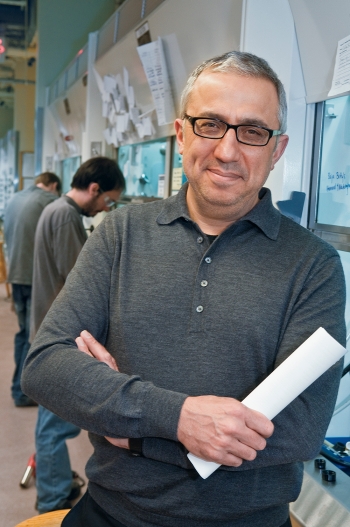
By
Researchers led by Vanderslice Millennium Professor of Chemistry and Chemistry Department Chairman Amir Hoveyda have created a new class of sustainable, small-molecule catalysts fueled by a single proton, the team recently reported in the prestigious scientific journal Nature.
The simple organic molecules offer a sustainable and highly efficient platform for chemical reactions that produce sets of molecules crucial to advances in medicine and the life sciences.
The team succeeded in conceptualizing a reliable, truly general, efficient synthesis of single mirror-image isomers, which have so far proven elusive for researchers. Previous methods suffered from a combination of extreme temperatures, long reaction times, limited scope, low selectivity, the need for rare or precious metals, and highly toxic elements.
Hoveyda said the new catalysts are small organic molecules derived from the abundant and renewable amino acid valine and can be synthesized in four steps through the use of commercially available and inexpensive materials.
The catalyst, used in as little as one quarter of one percent, promotes reactions that are complete within two minutes to four hours typically at room temperature, according to the co-authors, who include Professor of Chemistry Marc Snapper, Senior Research Associate Fredrik Haeffner, post-doctoral researchers Sebastian Torker and Tatiana Pilyugina, and graduate students Erika Vieira and Daniel Silverio.
Products formed consist mainly of a single mirror-image isomer of a large assortment of amines and alcohols, which serve as building blocks for the preparation of molecules capable of advancing new drug therapies relevant to human healthcare.
The team reported that the catalysts achieve high enantioselectivities – favoring one mirror-image isomer – as well as unprecedented rates of catalyst regeneration and product release.
“A reaction that can be initiated by a minute amount of a readily accessible and inexpensive catalyst to afford valuable organic molecules with high selectivity,” said Hoveyda, “and which requires only renewable resources, as opposed to precious and rare elements, is extremely important to future advances in medicine and the life sciences.”
The catalyst’s ability to provide access to prized enantiomerically enriched organic compounds in a manner that is not only efficient and selective but also economical and sustainable for the long term, will be of enormous value to researchers developing anti-cancer agents, therapeutics that reverse multi-drug resistance or anti-viral drugs.
“Chemical transformations that are highly selective as well as economical are very important for both discovery and commercial development of new therapeutic and diagnostic agents,” said Robert Lees, of the National Institutes of Health’s National Institute of General Medical Sciences, which partly funded the work. “The catalysts developed by Dr. Hoveyda represent an impressive advance because they can be used to inexpensively and predictably produce either isomer of a mirror image pair of molecules using mild reaction conditions.”
Hoveyda said the discovery will allow chemists to access many valuable organic molecules faster, cheaper and in a sustainable and economic fashion with minimal waste generation and without continuing to depend on diminishing reserves of precious metals.
“The new catalysts have all the key characteristics of a class of molecules that can serve as a blueprint for the invention of many additional important and useful reaction promoters in the future,” said Hoveyda.



